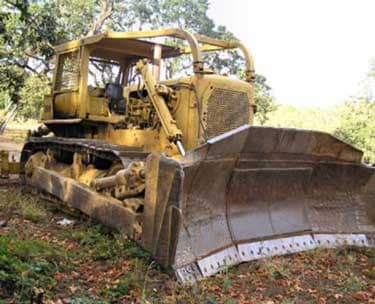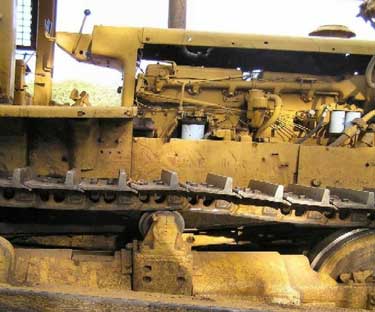Bulldozer Movement Kills Operator Standing on Track
Oregon Case Report: 05OR028
May 15, 2006
Summary
On August 20, 2005, a 33-year-old Hispanic equipment operator was killed when he slipped between the tracks and the body of the bulldozer he was operating. The operator gave a coworker a ride to retrieve an ATV located at the top of a hill where the operator was intending to work. The operator stopped the bulldozer on a fairly level area of the slope to let off his rider. He then noticed the coworker had left a jacket in the cab, so he lowered the tractor’s blade to the ground, put the machine into idle, and stood on the track to reach out and give the jacket to the coworker. While in this position, the tractor suddenly moved backward, and the operator lost his balance and fell feet first between the track and the deck. The bulldozer continued to roll 8-10 ft backward, and the operator was pulled beneath the tractor and crushed. Coworkers freed the conscious victim, but he was confirmed dead when emergency medical responders arrived at the scene. The medical examiner reported a blood alcohol content of 0.08, the level of legal intoxication in Oregon for operating a motor vehicle.

|
|
The Caterpillar D8H bulldozer in this incident unexpectedly rolled backward from a parked position.
|
Recommendations
- Before exiting a bulldozer, the operator must secure hazardous energy by following all manufacturer recommended steps in parking, including setting the parking brake.
- Operators should not use alcohol or other impairing drugs prior to or while operating equipment.
- No passengers should be permitted to ride on mobile machinery, unless a properly equipped seat is provided.
Introduction
On August 20, 2005, a 33-year-old Hispanic equipment operator was killed when he slipped between the tracks and the body of the bulldozer he was operating. OR-FACE was notified of the incident on August 22. An OR-FACE investigator visited the site on September 15, and conducted interviews with the employer and coworkers. This report is based on information from the site visit, and from Oregon OSHA, medical examiner, and newspaper reports.
The employer operated a small 540-acre organic vineyard and winery since 1997 in Oregon’s Willamette Valley wine country. The employer also owned and operated a building-truss manufacturing business. The vineyard and winery employed 5 full-time workers. An additional 70 contract laborers were hired part time for pruning and harvesting. At the time of the incident, 10 workers were in the vineyard, and 2 were at the site.
The employer provided on-the-job training in Spanish for Hispanic workers. Crew safety meetings were held every 2 weeks or 4 weeks, depending on the work season. On-the-job training (including Spanish safety videos), work observation, and verbal testing were provided by the bilingual foreman. Operator training for the bulldozer was provided in Spanish, with verbal and work observation testing. No operator certification was required either by the state or the employer.
The heavy equipment operator, although unschooled and unable to read or write, was fluent in speaking English and Spanish. He worked full time for this employer as a heavy equipment operator and excavator since immigrating to Oregon from Central Mexico 13 years earlier. He had worked at the vineyard for the past 8 years, operating the D8H Caterpillar bulldozer, and doing other jobs as needed during the busy seasons.
The 1979 Caterpillar D8H bulldozer, equipped with rollover protection and a seatbelt, was purchased used and came with the operational and maintenance manuals and records. The 45-ton bulldozer had the engine and multi-brake system overhauled 2 years prior to the incident. It was reported to be inspected and mechanically checked prior to each use, and was in good operating condition at the time of the incident.
Investigation
In the weeks preceding the incident, the operator had been clearing brush off the hillsides and woodlands, and smoothing ground around the vineyard with the bulldozer. The incident occurred on a Saturday morning at about 6:23 a.m. The operator had just begun his early morning shift, and was heading up a wooded hillside with the bulldozer when he encountered a coworker who needed to get to an ATV parked at the top of the hill. The operator gave the coworker a ride up the 10% grade hillside, and stopped in a relatively level area with a 2%-3% grade to let him get off. Noticing the coworker left a jacket in the cab, the operator lowered the bulldozer’s blade to the ground, put the engine into idle, and climbed out to stand on the track to hand the jacket to the coworker. He did not set the parking brake. The tractor suddenly moved backward, and the operator lost his balance and fell feet first between the track and deck. The bulldozer continued to roll 8-10 ft backward, and the operator was pulled beneath the tractor and crushed.
The coworker ran to the tractor, set the center brake to stop the machine, and called the foreman on the radio for help. The foreman ran up the hill and found the equipment operator pinned between the track and the body of the tractor. The foreman and coworker freed the conscious operator and laid him on the ground. The foreman called for emergency medical assistance and was given emergency instructions to perform before aid arrived. The victim was confirmed dead when emergency medical responders arrived at the scene.
The medical examiner reported the victim had a blood alcohol content of 0.08, considered legally intoxicated in Oregon for operating a motor vehicle.

|
|
On many bulldozer models, the operator must stand on the track to access the cab.
|
Cause of Death
Multiple traumatic injuries
Recommendations/Discussion
Recommendation #1: Before exiting a bulldozer, the operator must secure hazardous energy by following all manufacturer recommended steps in parking, including setting the parking brake.
The operator’s manual for Caterpillar D8 Tractors advises the following steps to park.
- Stop on level ground.
- Reduce engine speed.
- Move transmission control lever to neutral and engage safety lock.
- Apply brake pedals and engage brake lock.
- Lower all raised equipment to the ground. Apply a slight downward pressure.
The final advice to “apply a slight downward pressure” to the dropped blade or other raised equipment is a step added in the operator’s manual for the newest model of the Caterpillar D8 Tractor. Lowering the blade to the ground effectively stabilizes the machine from movement, more so by pushing the blade down into a penetrable surface rather than simply floating to a resting point.
This incident emphasizes the importance of completing all steps in the parking procedure before attempting to exit a bulldozer. Unlike forklift-type equipment, a bulldozer does not need to be completely turned off before exiting. A bulldozer engine requires a 5-minute rest at low idle before shutting off. On older machines, the running engine may also help maintain hydraulic power for brakes and equipment.
Recommendation #2. Operators should not use alcohol or other impairing drugs prior to or while operating equipment.
The victim’s 0.08 blood alcohol level raises concern that impaired judgment and reflexes may have contributed to this incident. Operators of heavy equipment and other machinery should not use alcohol or other impairing drugs, including over-the-counter medicines, prior to or while operating equipment.
Recommendation #3. No passengers should be permitted to ride on mobile machinery, unless a properly equipped seat is provided.
OSHA regulations prohibit riders on mobile machinery, unless a safe place to ride is provided (29 CFR 1926.602(c)(1)(vii)). Extra riders without a seat and seatbelt are especially vulnerable to being thrown off and crushed. The bulldozer in this case was not properly equipped for a passenger, and the employer prohibited operators from giving rides to coworkers. Refresher training on mobile machinery should include information on hazards to extra riders.
References
- Occupational Safety and Health Administration. Material handling equipment (29 CFR 1926.602). Regulations available online: https://www.osha.gov/pls/oshaweb/owadisp.
show_document?p_table=STANDARDS&p_id=10769external icon - Center for Research on Occupational and Environmental Toxicology. Powered industrial trucks. Online resource: http://www.croetweb.com/links.cfm?subtopicID=373external icon
- Substance Abuse and Mental Health Services Administration. Workplace Resource Center. Online resource (also in Spanish): http://workplace.samhsa.gov/external icon (Link updated 7/11/2007)
- U.S. Department of Health and Human Services. Drug-Free Workplace Helpline: 1-800-WORKPLACE. Employers can call for free guidance and technical assistance in setting up a substance abuse prevention program. Information is available in English and Spanish.
Oregon FACE Program
CROET at OHSU performs OR-FACE investigations through a cooperative agreement with the National Institute for Occupational Safety and Health (NIOSH), Division of Safety Research. The goal of these evaluations is to prevent fatal work injuries in the future by studying the work environment, the worker, the task, the tools, the fatal energy exchange, and the role of management in controlling how these factors interact.
To contact Oregon State FACE program personnel regarding State-based FACE reports, please use information listed on the Contact Sheet on the NIOSH FACE web site. Please contact In-house FACE program personnel regarding In-house FACE reports and to gain assistance when State-FACE program personnel cannot be reached.
Oregon FACE reports are for information, research, or occupational injury control only. Safety and health practices may have changed since the investigation was conducted and the report was completed. Persons needing regulatory compliance information should consult the appropriate regulatory agency.

